STT100 Statistics for Business: Sample Mean Hypothesis Testing
VerifiedAdded on 2023/03/30
|6
|1027
|277
Homework Assignment
AI Summary
This assignment focuses on hypothesis testing using sample mean and standard deviation, specifically examining the mean weight of female students in Australia compared to the national average. The study involves formulating null and alternative hypotheses, collecting sample data, and performing a t-test to determine if there is a significant difference between the sample mean and the population mean. The results indicate that the sample mean weight is not significantly different from the population mean, leading to the acceptance of the null hypothesis. The assignment also discusses potential Type I and Type II errors and provides justification for the findings based on existing literature and reports on obesity and weight trends in Australia. References to relevant sources, including the Australian Bureau of Statistics, are included to support the analysis and conclusions.

SAMPLE MEAN AND STANDARD DEVIATION 1
Research and Hypothesis Testing
Name
Course
Professor’s Name
University
State
Date
.
Research and Hypothesis Testing
Name
Course
Professor’s Name
University
State
Date
.
Paraphrase This Document
Need a fresh take? Get an instant paraphrase of this document with our AI Paraphraser
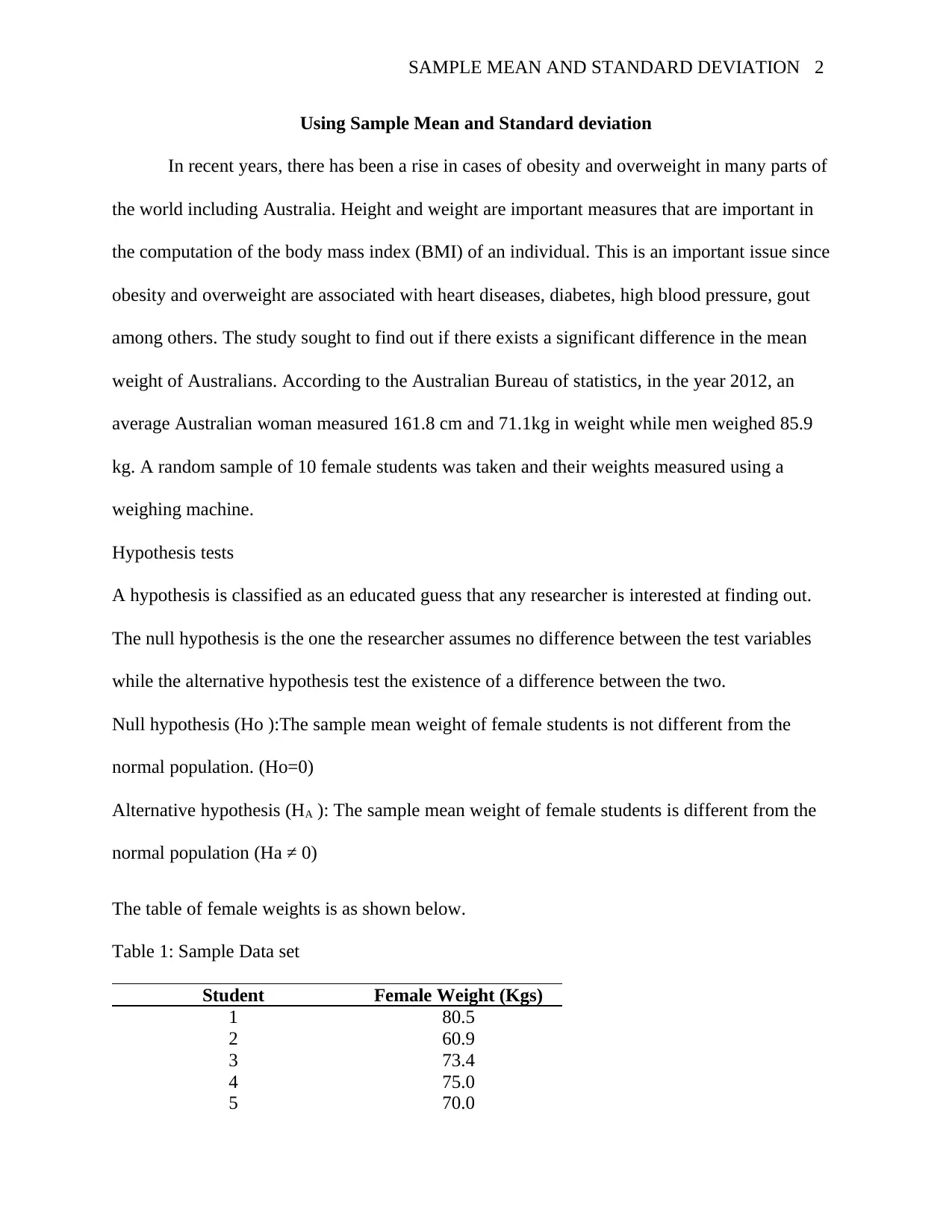
SAMPLE MEAN AND STANDARD DEVIATION 2
Using Sample Mean and Standard deviation
In recent years, there has been a rise in cases of obesity and overweight in many parts of
the world including Australia. Height and weight are important measures that are important in
the computation of the body mass index (BMI) of an individual. This is an important issue since
obesity and overweight are associated with heart diseases, diabetes, high blood pressure, gout
among others. The study sought to find out if there exists a significant difference in the mean
weight of Australians. According to the Australian Bureau of statistics, in the year 2012, an
average Australian woman measured 161.8 cm and 71.1kg in weight while men weighed 85.9
kg. A random sample of 10 female students was taken and their weights measured using a
weighing machine.
Hypothesis tests
A hypothesis is classified as an educated guess that any researcher is interested at finding out.
The null hypothesis is the one the researcher assumes no difference between the test variables
while the alternative hypothesis test the existence of a difference between the two.
Null hypothesis (Ho ):The sample mean weight of female students is not different from the
normal population. (Ho=0)
Alternative hypothesis (HA ): The sample mean weight of female students is different from the
normal population (Ha ≠ 0)
The table of female weights is as shown below.
Table 1: Sample Data set
Student Female Weight (Kgs)
1 80.5
2 60.9
3 73.4
4 75.0
5 70.0
Using Sample Mean and Standard deviation
In recent years, there has been a rise in cases of obesity and overweight in many parts of
the world including Australia. Height and weight are important measures that are important in
the computation of the body mass index (BMI) of an individual. This is an important issue since
obesity and overweight are associated with heart diseases, diabetes, high blood pressure, gout
among others. The study sought to find out if there exists a significant difference in the mean
weight of Australians. According to the Australian Bureau of statistics, in the year 2012, an
average Australian woman measured 161.8 cm and 71.1kg in weight while men weighed 85.9
kg. A random sample of 10 female students was taken and their weights measured using a
weighing machine.
Hypothesis tests
A hypothesis is classified as an educated guess that any researcher is interested at finding out.
The null hypothesis is the one the researcher assumes no difference between the test variables
while the alternative hypothesis test the existence of a difference between the two.
Null hypothesis (Ho ):The sample mean weight of female students is not different from the
normal population. (Ho=0)
Alternative hypothesis (HA ): The sample mean weight of female students is different from the
normal population (Ha ≠ 0)
The table of female weights is as shown below.
Table 1: Sample Data set
Student Female Weight (Kgs)
1 80.5
2 60.9
3 73.4
4 75.0
5 70.0
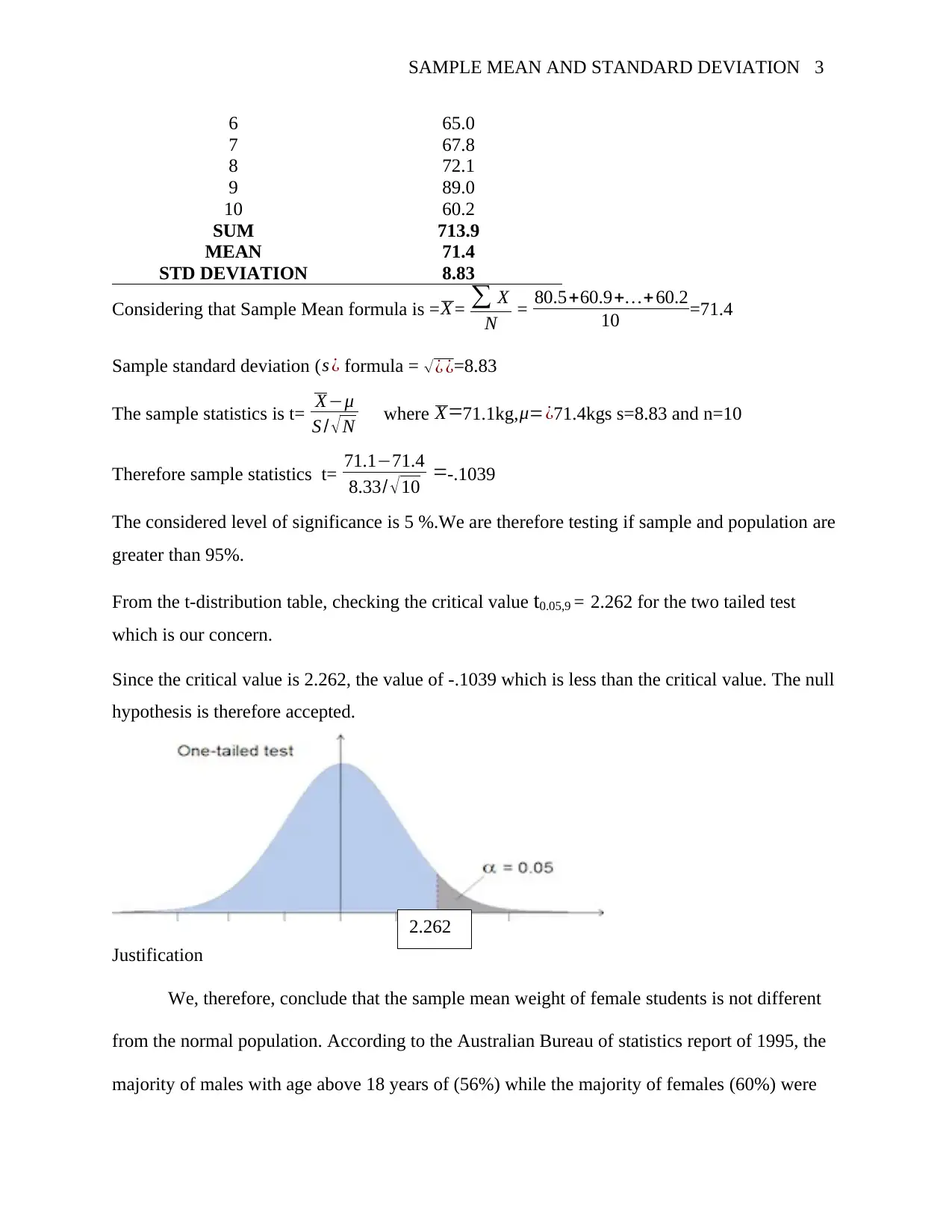
SAMPLE MEAN AND STANDARD DEVIATION 3
6 65.0
7 67.8
8 72.1
9 89.0
10 60.2
SUM 713.9
MEAN 71.4
STD DEVIATION 8.83
Considering that Sample Mean formula is = X = ∑ X
N = 80.5+60.9+…+60.2
10 =71.4
Sample standard deviation ( s ¿ formula = √ ¿ ¿=8.83
The sample statistics is t= X−μ
S / √N where X =71.1kg,μ=¿71.4kgs s=8.83 and n=10
Therefore sample statistics t= 71.1−71.4
8.33/ √ 10 =-.1039
The considered level of significance is 5 %.We are therefore testing if sample and population are
greater than 95%.
From the t-distribution table, checking the critical value t0.05,9 = 2.262 for the two tailed test
which is our concern.
Since the critical value is 2.262, the value of -.1039 which is less than the critical value. The null
hypothesis is therefore accepted.
Justification
We, therefore, conclude that the sample mean weight of female students is not different
from the normal population. According to the Australian Bureau of statistics report of 1995, the
majority of males with age above 18 years of (56%) while the majority of females (60%) were
2.262
6 65.0
7 67.8
8 72.1
9 89.0
10 60.2
SUM 713.9
MEAN 71.4
STD DEVIATION 8.83
Considering that Sample Mean formula is = X = ∑ X
N = 80.5+60.9+…+60.2
10 =71.4
Sample standard deviation ( s ¿ formula = √ ¿ ¿=8.83
The sample statistics is t= X−μ
S / √N where X =71.1kg,μ=¿71.4kgs s=8.83 and n=10
Therefore sample statistics t= 71.1−71.4
8.33/ √ 10 =-.1039
The considered level of significance is 5 %.We are therefore testing if sample and population are
greater than 95%.
From the t-distribution table, checking the critical value t0.05,9 = 2.262 for the two tailed test
which is our concern.
Since the critical value is 2.262, the value of -.1039 which is less than the critical value. The null
hypothesis is therefore accepted.
Justification
We, therefore, conclude that the sample mean weight of female students is not different
from the normal population. According to the Australian Bureau of statistics report of 1995, the
majority of males with age above 18 years of (56%) while the majority of females (60%) were
2.262
⊘ This is a preview!⊘
Do you want full access?
Subscribe today to unlock all pages.

Trusted by 1+ million students worldwide
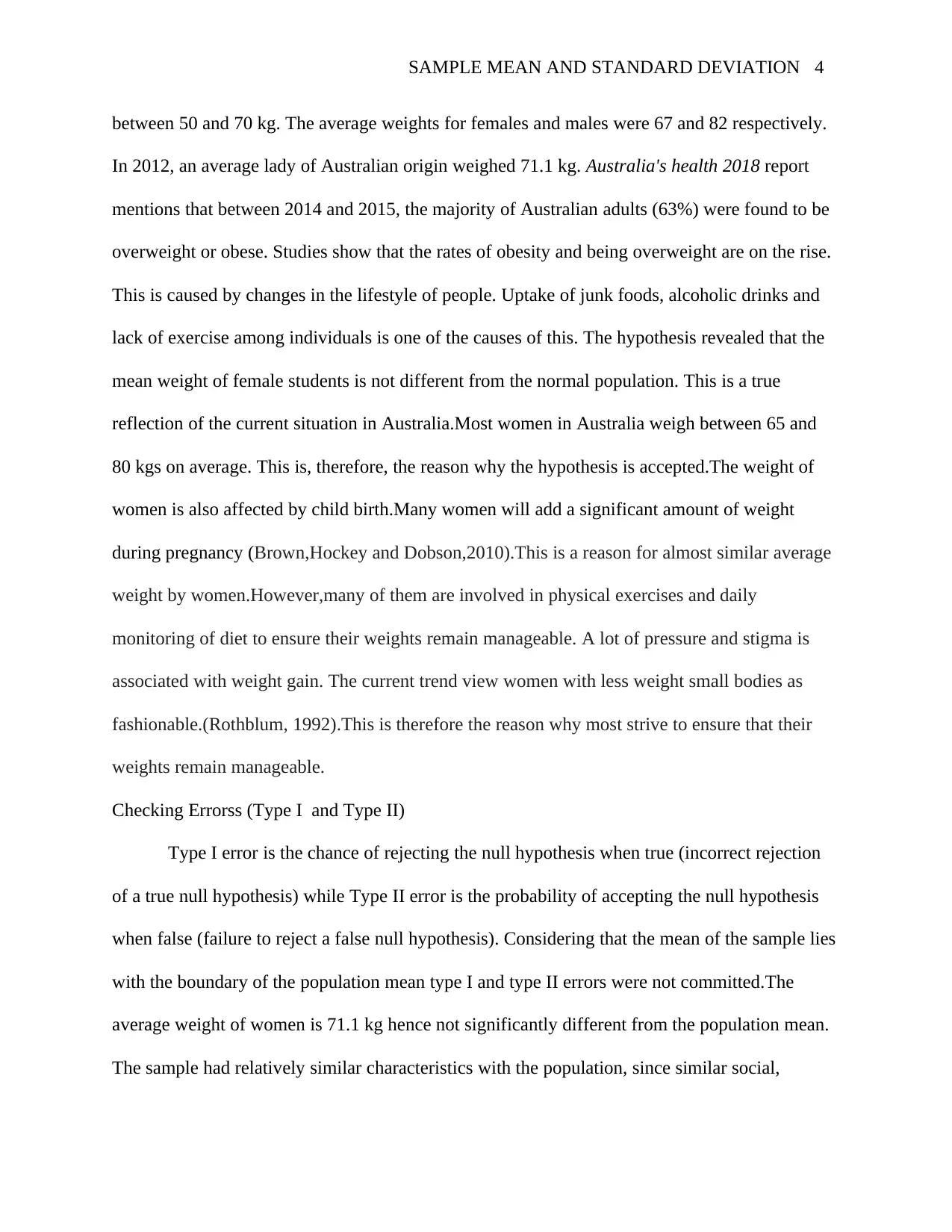
SAMPLE MEAN AND STANDARD DEVIATION 4
between 50 and 70 kg. The average weights for females and males were 67 and 82 respectively.
In 2012, an average lady of Australian origin weighed 71.1 kg. Australia's health 2018 report
mentions that between 2014 and 2015, the majority of Australian adults (63%) were found to be
overweight or obese. Studies show that the rates of obesity and being overweight are on the rise.
This is caused by changes in the lifestyle of people. Uptake of junk foods, alcoholic drinks and
lack of exercise among individuals is one of the causes of this. The hypothesis revealed that the
mean weight of female students is not different from the normal population. This is a true
reflection of the current situation in Australia.Most women in Australia weigh between 65 and
80 kgs on average. This is, therefore, the reason why the hypothesis is accepted.The weight of
women is also affected by child birth.Many women will add a significant amount of weight
during pregnancy (Brown,Hockey and Dobson,2010).This is a reason for almost similar average
weight by women.However,many of them are involved in physical exercises and daily
monitoring of diet to ensure their weights remain manageable. A lot of pressure and stigma is
associated with weight gain. The current trend view women with less weight small bodies as
fashionable.(Rothblum, 1992).This is therefore the reason why most strive to ensure that their
weights remain manageable.
Checking Errorss (Type I and Type II)
Type I error is the chance of rejecting the null hypothesis when true (incorrect rejection
of a true null hypothesis) while Type II error is the probability of accepting the null hypothesis
when false (failure to reject a false null hypothesis). Considering that the mean of the sample lies
with the boundary of the population mean type I and type II errors were not committed.The
average weight of women is 71.1 kg hence not significantly different from the population mean.
The sample had relatively similar characteristics with the population, since similar social,
between 50 and 70 kg. The average weights for females and males were 67 and 82 respectively.
In 2012, an average lady of Australian origin weighed 71.1 kg. Australia's health 2018 report
mentions that between 2014 and 2015, the majority of Australian adults (63%) were found to be
overweight or obese. Studies show that the rates of obesity and being overweight are on the rise.
This is caused by changes in the lifestyle of people. Uptake of junk foods, alcoholic drinks and
lack of exercise among individuals is one of the causes of this. The hypothesis revealed that the
mean weight of female students is not different from the normal population. This is a true
reflection of the current situation in Australia.Most women in Australia weigh between 65 and
80 kgs on average. This is, therefore, the reason why the hypothesis is accepted.The weight of
women is also affected by child birth.Many women will add a significant amount of weight
during pregnancy (Brown,Hockey and Dobson,2010).This is a reason for almost similar average
weight by women.However,many of them are involved in physical exercises and daily
monitoring of diet to ensure their weights remain manageable. A lot of pressure and stigma is
associated with weight gain. The current trend view women with less weight small bodies as
fashionable.(Rothblum, 1992).This is therefore the reason why most strive to ensure that their
weights remain manageable.
Checking Errorss (Type I and Type II)
Type I error is the chance of rejecting the null hypothesis when true (incorrect rejection
of a true null hypothesis) while Type II error is the probability of accepting the null hypothesis
when false (failure to reject a false null hypothesis). Considering that the mean of the sample lies
with the boundary of the population mean type I and type II errors were not committed.The
average weight of women is 71.1 kg hence not significantly different from the population mean.
The sample had relatively similar characteristics with the population, since similar social,
Paraphrase This Document
Need a fresh take? Get an instant paraphrase of this document with our AI Paraphraser
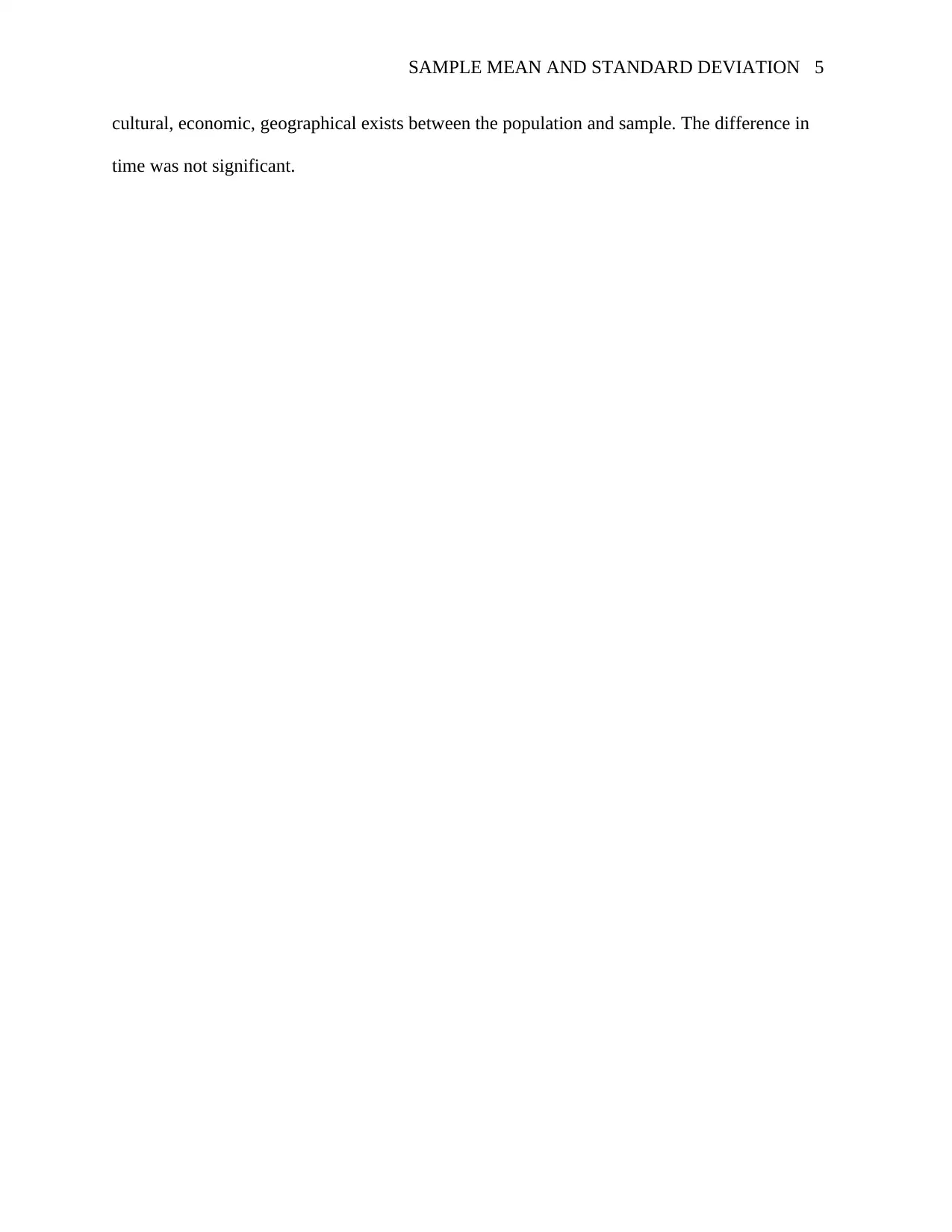
SAMPLE MEAN AND STANDARD DEVIATION 5
cultural, economic, geographical exists between the population and sample. The difference in
time was not significant.
cultural, economic, geographical exists between the population and sample. The difference in
time was not significant.
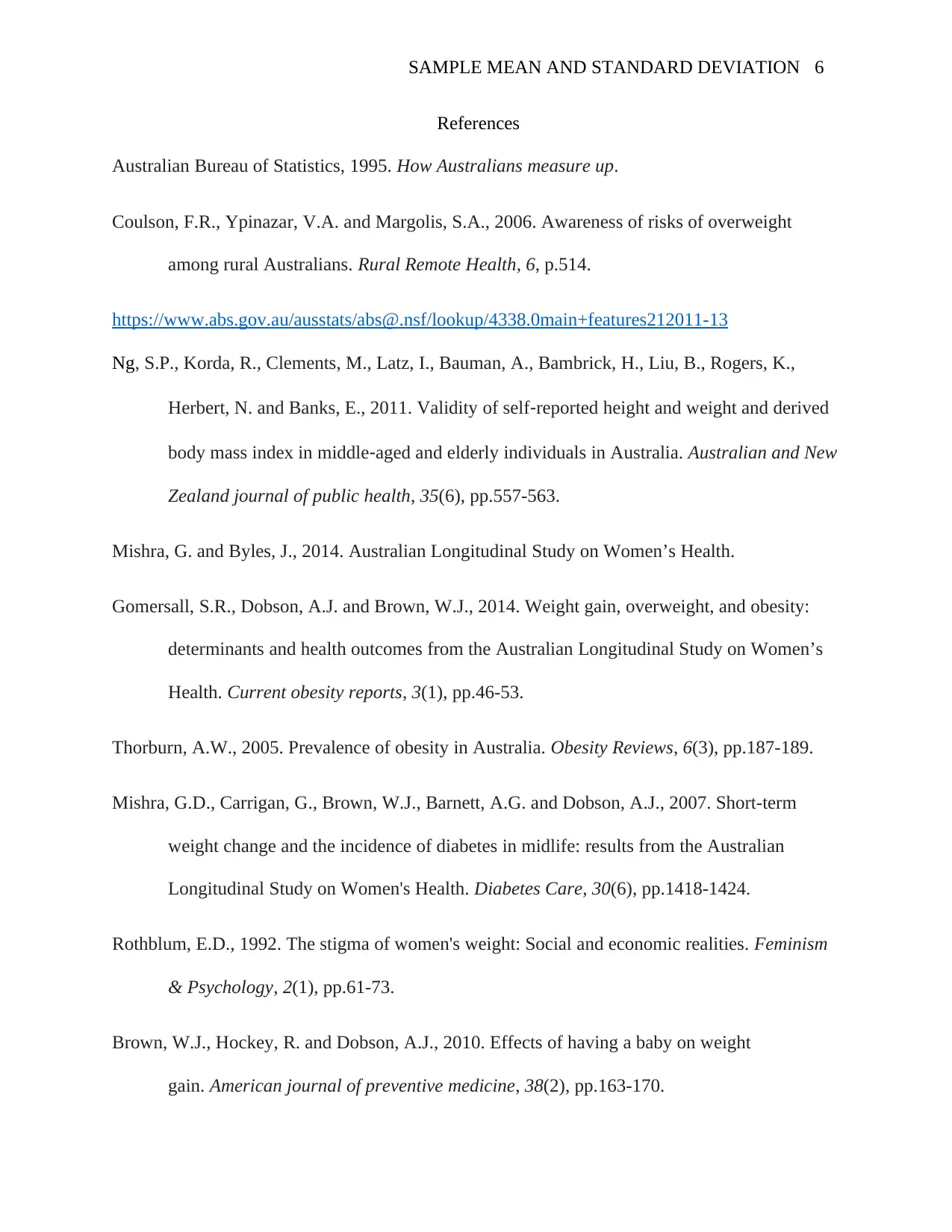
SAMPLE MEAN AND STANDARD DEVIATION 6
References
Australian Bureau of Statistics, 1995. How Australians measure up.
Coulson, F.R., Ypinazar, V.A. and Margolis, S.A., 2006. Awareness of risks of overweight
among rural Australians. Rural Remote Health, 6, p.514.
https://www.abs.gov.au/ausstats/abs@.nsf/lookup/4338.0main+features212011-13
Ng, S.P., Korda, R., Clements, M., Latz, I., Bauman, A., Bambrick, H., Liu, B., Rogers, K.,
Herbert, N. and Banks, E., 2011. Validity of self‐reported height and weight and derived
body mass index in middle‐aged and elderly individuals in Australia. Australian and New
Zealand journal of public health, 35(6), pp.557-563.
Mishra, G. and Byles, J., 2014. Australian Longitudinal Study on Women’s Health.
Gomersall, S.R., Dobson, A.J. and Brown, W.J., 2014. Weight gain, overweight, and obesity:
determinants and health outcomes from the Australian Longitudinal Study on Women’s
Health. Current obesity reports, 3(1), pp.46-53.
Thorburn, A.W., 2005. Prevalence of obesity in Australia. Obesity Reviews, 6(3), pp.187-189.
Mishra, G.D., Carrigan, G., Brown, W.J., Barnett, A.G. and Dobson, A.J., 2007. Short-term
weight change and the incidence of diabetes in midlife: results from the Australian
Longitudinal Study on Women's Health. Diabetes Care, 30(6), pp.1418-1424.
Rothblum, E.D., 1992. The stigma of women's weight: Social and economic realities. Feminism
& Psychology, 2(1), pp.61-73.
Brown, W.J., Hockey, R. and Dobson, A.J., 2010. Effects of having a baby on weight
gain. American journal of preventive medicine, 38(2), pp.163-170.
References
Australian Bureau of Statistics, 1995. How Australians measure up.
Coulson, F.R., Ypinazar, V.A. and Margolis, S.A., 2006. Awareness of risks of overweight
among rural Australians. Rural Remote Health, 6, p.514.
https://www.abs.gov.au/ausstats/abs@.nsf/lookup/4338.0main+features212011-13
Ng, S.P., Korda, R., Clements, M., Latz, I., Bauman, A., Bambrick, H., Liu, B., Rogers, K.,
Herbert, N. and Banks, E., 2011. Validity of self‐reported height and weight and derived
body mass index in middle‐aged and elderly individuals in Australia. Australian and New
Zealand journal of public health, 35(6), pp.557-563.
Mishra, G. and Byles, J., 2014. Australian Longitudinal Study on Women’s Health.
Gomersall, S.R., Dobson, A.J. and Brown, W.J., 2014. Weight gain, overweight, and obesity:
determinants and health outcomes from the Australian Longitudinal Study on Women’s
Health. Current obesity reports, 3(1), pp.46-53.
Thorburn, A.W., 2005. Prevalence of obesity in Australia. Obesity Reviews, 6(3), pp.187-189.
Mishra, G.D., Carrigan, G., Brown, W.J., Barnett, A.G. and Dobson, A.J., 2007. Short-term
weight change and the incidence of diabetes in midlife: results from the Australian
Longitudinal Study on Women's Health. Diabetes Care, 30(6), pp.1418-1424.
Rothblum, E.D., 1992. The stigma of women's weight: Social and economic realities. Feminism
& Psychology, 2(1), pp.61-73.
Brown, W.J., Hockey, R. and Dobson, A.J., 2010. Effects of having a baby on weight
gain. American journal of preventive medicine, 38(2), pp.163-170.
⊘ This is a preview!⊘
Do you want full access?
Subscribe today to unlock all pages.

Trusted by 1+ million students worldwide
1 out of 6
Related Documents
Your All-in-One AI-Powered Toolkit for Academic Success.
+13062052269
info@desklib.com
Available 24*7 on WhatsApp / Email
![[object Object]](/_next/static/media/star-bottom.7253800d.svg)
Unlock your academic potential
Copyright © 2020–2025 A2Z Services. All Rights Reserved. Developed and managed by ZUCOL.




